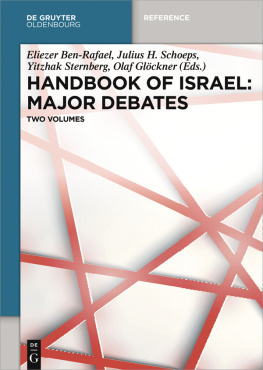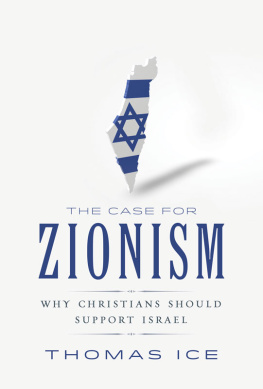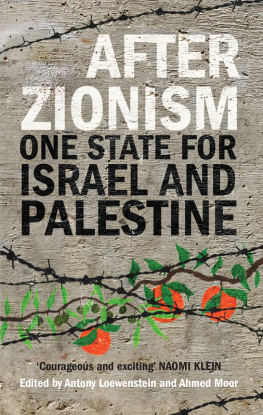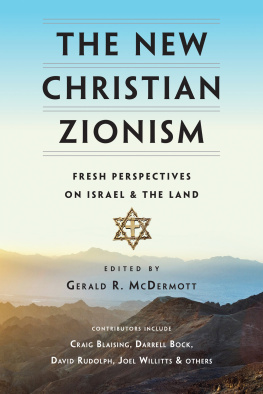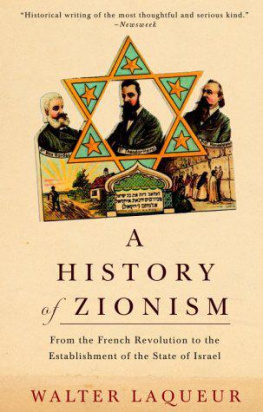Guide

Handbook of Israel: Major Debates

Scientific Advisory Board
Majid Al-Haj
Gad Barzilai
Pierre Birnbaum
Judit Bokser Liwerant
Chantal Bordes-Benayoun
Christina von Braun
Sergio DellaPergola
Alain Dieckhoff
Menachem Friedman
Yosef Gorny
Eva Illouz
Amal Jamal
Shalom Ratzabi
Shulamit Reinharz
William Safran
Gershon Shafir
Gabriel Sheffer
Sammy Smooha
Zeev Sternhell
Shmuel Trigano
Karin Wilhelm

The project Handbook of Israel: Major Debates has been generously funded by the Moses Mendelssohn Foundation, Erlangen/Berlin.
ISBN 978-3-11-035160-6
e-ISBN (PDF) 978-3-11-035163-7
e-ISBN (EPUB) 978-3-11-038338-6
Library of Congress Cataloging-in-Publication Data
A CIP catalog record for this book has been applied for at the Library of Congress.
Bibliografische Information der Deutschen Nationalbibliothek
Die Deutsche Nationalbibliothek verzeichnet diese Publikation in der
Deutschen Nationalbibliografie; detaillierte bibliografische Daten sind im Internet ber http://dnb.dnb.de abrufbar.
2016 Walter de Gruyter GmbH, Berlin/Boston
Cover image: thinkstock, alexdndz
Typesetting: bsix information exchange GmbH, Braunschweig
www.degruyter.com
Foreword
Israel is one of the most disputed settings in the world. Its presence in the media is incommensurate with its geographic and demographic size. Any event in the region, any incident within or without, is immediately the focus of attention from the world media. The Israelis themselves are, as a rule, avid consumers of news who debate among themselves the significance of almost every issue reaching the public agenda. The opinions are anything but consensual: the harshest oppositions, denials, and confrontations animate the countrys public life, and beyond it, the Jewish world as a whole in tandem with world opinion.
This is the context in which this Handbook is aimed at presenting major issues that divide the academic community with respect to the analysis of Israeli society. It consists of thirteen topics grouped into three parts Cleavages, The Challenge of Post-Zionism, and Israel Outward that discuss questions ranging from the nature of Israeli democracy to the role of religion in the state and society. For each topic, we present high-standard contributions from most experienced and renowned scholars working on the various aspects considered. These scholars represent a range of prevailing contradictory views of the issues under consideration. For each topic, several scholars were asked to contribute an essay revealing their perspective.
In this complex task, we are grateful to the members of the Scientific Advisory Board of the Handbook, and of course to De Gruyter Oldenbourg for its encouragement and kind readiness to extend the utmost help all along this long-term undertaking. We wish to thank Diana Rubanenko for her efficient work on translations and language editing and her continuous agreeable and cooperative disposition.
Last but not least, the academic editors of this handbook are immensely grateful to the Editorial Manager, Anne Weberling, for her dedicated, most efficient and outstanding work on this project.
General Introduction
A case of interest
In many respects, Israel is a highly complex societal case. To validate this assessment, it suffices to consider the very premises that led to its creation.
Israel is a state that was founded by Jews with the declared intention of creating a homeland for Jews dispersed across the world. In this, Zionists saw themselves as the vanguard of the Jewish people and, as such, they defined themselves as firmly anchored in Judaism. Zionism thus fully endorsed the principle of the religion-people unity that has always been of primordial importance in Judaism. merging language, ideas, and symbols, with given individual practices, behavioral patterns, and institutional features. The term caste responds to what Dumont (1977) considers as an entity that sees itself as part of a larger system in which its aspirations have general transcendental impacts.
With the advent of the modern era and Jewish emancipation, many Jews began examining the deep structures of Jewish identity in new ways, and questioned the validity of traditional assessments. The first question was whether Jews were still primarily a religious entity as asserted over centuries or rather a social and cultural community. A second question inquired about the present-day singularity of the collective. Growing cohorts of Jews now saw in Judaism essentially a culture, a set of symbols, and a historical legacy rather than a religion. A third question concerned the allegiance to the Land of Israel and the definition of any location outside it as galut , i.e., exile. Some Jews wondered whether that token is a metaphor for the quest for a genuine and secure home. Out of the numerous approaches to these
Zionism proposed a national solution. From the traditions, it retained the definition of Jewish life outside the land as exile, but instead of relying on observance of the religious commandments in the hope that the Messiah will come, it called for the resettlement of Jews in the ancient Land of Israel. To a certain extent, Zionism borrowed this association of nationhood and territory from European nationalisms that effectively corresponded to traditional Judaisms longing for Return. This phrasing of traditional aspirations in a mode of modern nationalism appealed to large circles of Jewish youth in Eastern Europe, who conducted a kind of transformation by translating the traditional codes into a set of new practical exigencies.
Yet, through the very break with traditional Judaism by seeking redemption independent of religious devotion, Zionism remained attached to Judaisms basic identity exigencies. It offered a secular and political alternative to the religious aspiration of Return, toward the Promised Land. In other words, Zionism exited the caste syndrome, but not Judaism. This move, however, was also and still is a source of acute polemics: the ultra-Orthodox have not only opposed Zionism, they have also joined it, de facto, by constituting what is by now an important component of the population. This segment continues under new terms and conditions to fight on behalf of the status and influence of traditional Judaism among Jews worldwide, and especially in Israel where they found the ideal conditions for flourishing.
In at least one respect, Zionism is at a disadvantage vis--vis traditional Judaism. The caste model links the redemption of the Jews to that of the whole world; Zionism aspires to Jewish redemption alone the normalization of the Jewish people. The price is the exposure of Zionism to the criticism of those who see it as a form of collective assimilation into the non-Jewish world on the basis of the latters principles. The classic Zionist leaders responded by claiming that it was their intention to build an enlightened society that would be a light unto the nations. That was what normalization of the Jewish people was about. By taking up this challenge, that combined modern secular contents with Jewish inspiration, the Zionists presented an ideological alternative to the view of the Jewish nation as the carrier of the promise of messianic redemption.

